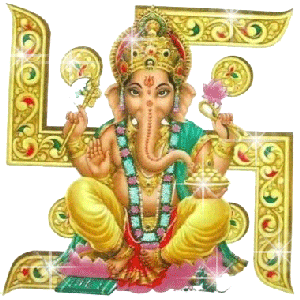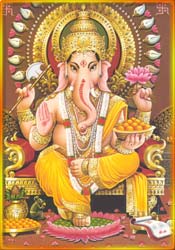 Prayer or worship is considered to be an integral part of theHindu way of living. The chanting of mantras is the most popular form of worship in Hinduism. Yoga and meditation are also considered as a form of devotional service towards the Lord. The Picture to the right represents the Ohm sign, which is a sound of peace.
Prayer or worship is considered to be an integral part of theHindu way of living. The chanting of mantras is the most popular form of worship in Hinduism. Yoga and meditation are also considered as a form of devotional service towards the Lord. The Picture to the right represents the Ohm sign, which is a sound of peace.
The Vedas are a collection of liturgy (mantras, hymns)
The Hindu devotional Bhakti movements emphasizes repetitive prayer. Stemming from the universal Soul or Brahman, prayer is focused on the personal forms of God, such as Shiva, Vishnu, or Vishnu's Avatars, Rama and Krishna
Before the process of ritual, before the invoking of different deities for the fulfillment of various needs, came the human aspiration to the highest truth, the foundational monism of Hinduism, pertaining ultimately to the one Brahman. Brahman, which summarily can be called the unknowable, true, infinite and blissful Divine Ground, is the source and being of all existence from which the cosmos springs. This is the essence of the Vedic system. The following prayer was part and parcel of all the Vedic ceremonies and continues to be invoked even today in Hindu temples all over India and other countries around the world, and exemplifies this essence:
Mantras
Mantras popular in contemporary Hinduism:
Asato maa sadgamaya
Tamaso maa jyotirgamaya
Mṛityor maa amṛitan gamaya
Om shaanti shaanti shaanti
“From the unreal, lead us to the Real; from darkness, lead us unto Light; from death, lead us to Immortality. Om peace, peace, peace.”
May all be happy. May all be healthy. May we all experience what is good and let no one suffer.
Gayatri Mantra
The Gayatri mantra is Hinduism's most representative prayer. Hindus recite it on a daily basis, not only contemplating its straightforward meaning, but also dwelling on and imbibing its sound, regarded to be pregnant with spiritual meaning. For this reason nearly all Hindu prayers and mantras are sung. The Gayatri was first recorded in the Rig Veda (iii, 62, 10) which was composed in Sanskrit about 1500b - 2500 years ago, and by some reports, the mantra may have been chanted for many generations before that.
Bhakti YogaDescribed in the Bhagavad Gita Bhakti Yoga is the path of love and devotion. On Bhakti Yoga:
".... those who, renouncing all actions in Me, and regarding Me as the Supreme, worship Me... of those whose thoughts have entered into Me, I am soon the deliverer from the ocean of death and transmigration, Arjuna. Keep your mind on Me alone, your intellect on Me. Thus you shall dwell in Me hereafter." (B.G., Chapter 12, Verses 6-8).
It is essentially the process of enlightenment found through worship of God, in whatever form one envisions. Prayer is achieved through puja (worship) done either at the family shrine or a local temple. We can see from Krishna's injunction that prayer is fundamental to Hinduism, that to dwell constantly on God is key to enlightenment. Prayer repetition (through mantras) using maalaas (Hindu prayer beads) are a strong part of Hinduism.
The devotionalist Bhakti movement originates in South India in the Early Middle Ages, and by the Late Middle Ages spread throughout the subcontinent, giving rise to Sant Mat and Gaudiya Vaishnavism. Stemming from the highest Creator God called Brahman, prayer is focused on His many manifestations, including primarily Shiva and Vishnu. Some other extremely popular deities areKrishna and Rama (in Vaishna devotionalism seen as incarnations of Vishnu), Ma Kali (Mother Kali, the feminine deity, or Mother Goddess, aka Durga, Parvati, Shakti, etc.) and Ganesha (the famous elephant-headed God of wisdom). It is epitomised by the devotion of the monkey God Hanuman for his Lord Rama. Another major form of prayer for Hindus involves a heavy focus on meditation, through Hindu yoga that stills the mind in order to focus on God.



